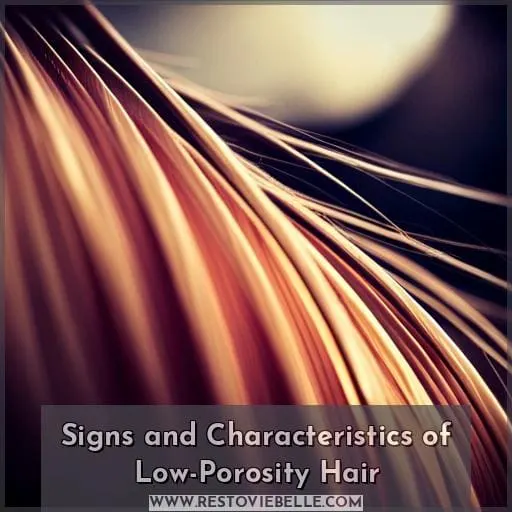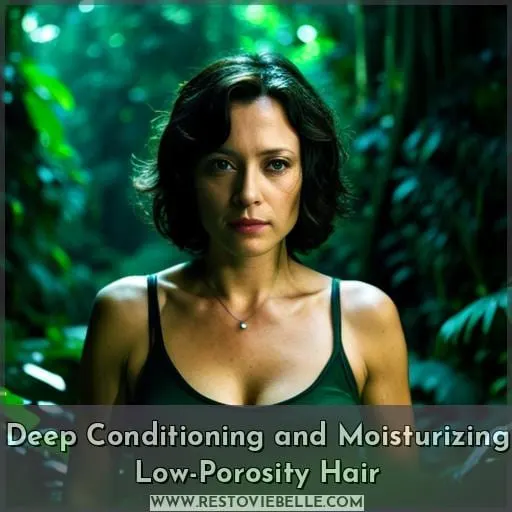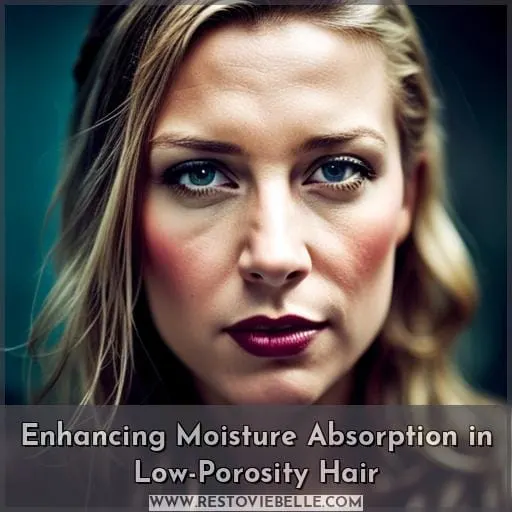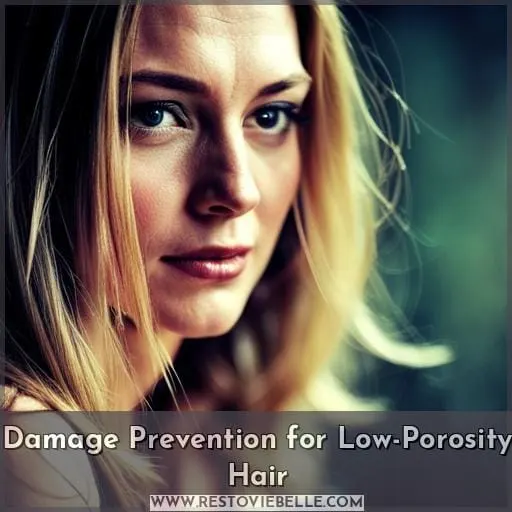This site is supported by our readers. We may earn a commission, at no cost to you, if you purchase through links.
 Caring for low porosity hair can seem like a daunting task. But with the right tips, techniques, and products, you’ll be managing your locks in no time!
Caring for low porosity hair can seem like a daunting task. But with the right tips, techniques, and products, you’ll be managing your locks in no time!
From understanding what low-porosity hair is to selecting the best shampoo, deep conditioning methods, and moisturizing techniques – this article has it all covered.
Learn how to wash your low porosity strands safely while avoiding damage. Plus, get personalized care advice tailored specifically for your hair type.
Unlock the secrets of mastering natural beauty and discover how to make every day a good head day with our ultimate guide on washing and caring for low-porosity tresses!
Table Of Contents
- Key Takeaways
- Understanding Low-Porosity Hair
- Signs and Characteristics of Low-Porosity Hair
- Washing Low-Porosity Hair
- Deep Conditioning and Moisturizing Low-Porosity Hair
- Enhancing Moisture Absorption in Low-Porosity Hair
- Damage Prevention for Low-Porosity Hair
- Hair Care Tips for Low-Porosity Hair
- Personalized Care for Low-Porosity Hair
- Frequently Asked Questions (FAQs)
- What are the best products to use for low porosity hair?
- How frequently should I wash my low porosity hair?
- Is there a way to reduce the time it takes to dry my low porosity hair?
- Does low porosity hair require more or less maintenance than other types of hair?
- What is the best way to prevent damage to my low porosity hair?
- Conclusion
Key Takeaways
- Wash low porosity hair with warm water to open the cuticles for better product penetration.
- Perform a pre-poo treatment with oil before shampooing every 1-2 weeks to maintain softness.
- Choose a clarifying shampoo bar or charcoal cleanser for washing low-porosity locks every 1-2 weeks.
- Detangle strands before shampooing and select a gentle clarifying shampoo.
Understanding Low-Porosity Hair
Understanding your low-porosity hair can be daunting, but taking the time to find what works for you is worth it for hydrated and defined curls.
Low porosity hair types have tightly packed cuticles which resist moisture absorption—making them difficult to manage. To identify if you have low porosity, do the strand test and look out for signs like products sitting on top of your strands or buildup from oils or creams.
When washing your locks, use warm water to open up those cuticles and allow product penetration. Also, consider a pre-poo treatment with oil before shampooing every one to two weeks in order to maintain softness without overloading it with heavy oils that will cause build up quickly.
Afterward, apply light conditioners such as a leave-in along with styling products suited towards this type of texture like gels specifically made for curl definition while protecting against heat damage too! Taking extra care when dealing with these unique textures will help keep breakage at bay while providing softer, more manageable curls!
So take some time understanding how best to nourish this special kind of mane so that you can enjoy beautiful hydrating results day after day without compromising its health in any way!
Signs and Characteristics of Low-Porosity Hair
You can easily identify low-porosity hair by its characteristic resistance to moisture, as its cuticles are tightly aligned and don’t absorb water quickly. Signs of this type of hair include products sitting on top rather than being absorbed, buildup which leads to an oily feel, and frizziness that is hard to control.
To prevent product buildup from occurring in the first place, you should be washing your low-porosity locks every 1-2 weeks with a clarifying shampoo bar or charcoal cleanser. This will open up the cuticle structure so that it becomes more receptive towards hydration from conditioners and other treatments such as pre-pooing with oils prior to cleansing for additional oil barriers against drying out your strands further.
Additionally, avoid using heavy creams or butters when styling as well since these will only add onto the existing buildup issue you may have already been facing due to poor water solubility characteristics of this type.
The key here is understanding exactly what kind of porosity level your own hair has through doing a simple strand test – then adapting accordingly so that weekly wash routines become less tedious yet still effective at maintaining healthy tresses over time!
Washing Low-Porosity Hair
Caring for low porosity hair can be challenging, but with the right knowledge and techniques, you can keep your curls hydrated and defined. Washing is an important part of any hair care routine—prepare by detangling strands before shampooing, select a gentle clarifying shampoo formulated specifically for low porosity hair types, then use lukewarm water to help open up cuticles during washing.
Preparing Hair for Washing
Before washing your low-porosity hair, prep it with a pre-poo treatment to open up the cuticles and help moisture absorption. Use warm water for optimal hydration and consider using a heat cap or steamer to further enhance this moisturizing technique.
Choose an appropriate shampoo bar or clarifying charcoal product depending on your results from the strand test. Avoid heavy oils, proteins, and creams that may not be suitable for this type of hair texture.
Instead, opt for lightweight leave-in conditioners to get maximum benefits out of each hair treatment! With patience and proper care, you can achieve hydrated, defined curls without compromising their health.
Choosing the Right Shampoo
When selecting a shampoo for low porosity hair, opt for one that’s specifically designed to penetrate the tightly-aligned cuticles.
Wash with warm water and use an oil pre-poo treatment if necessary. Follow up with light conditioners to aid in moisture retention, then style as needed using moisturizing products like leave-ins, gels, and styling lotions.
Create a weekly routine tailored to your needs by experimenting with different techniques until you find what works best! Keep in mind that avoiding overuse of proteins, heat tools, or chemical processing can help prevent damage, while investing in effective care such as hair steamers is essential too!
Washing Techniques for Low-Porosity Hair
To keep your curls hydrated and defined, try using warm water to open up cuticles when washing low-porosity hair – like unlocking a treasure chest! Conditioning with lightweight, water-based products can help prevent damage.
Hair steaming is another great way to lift the cuticles for better moisture absorption. Consider incorporating leave-in conditioners or hydrating mists into your night routine for extra definition and protection.
Product selection is key: avoid heavy oils or cream-based products and opt instead for lighter gels as part of styling aftercare.
Deep Conditioning and Moisturizing Low-Porosity Hair
Taking care of low-porosity hair requires a different approach than other types due to its resistance to moisture. To successfully deep condition and moisturize your curls, there are specific techniques that you should implement into your routine, such as pre-poo treatments, steaming or heat caps for better absorption, and lightweight products like leave-in conditioners.
Deep Conditioning Methods
Try deep conditioning your low-porosity hair with a nourishing mask for maximum hydration and defined curls. Use heat tools sparingly to prevent damage, and limit oil usage as well. Only do protein treatments once every few weeks.
To lock in moisture, use an oil treatment before washing or a leave-in conditioner afterwards on wet hair strands. A hydrating product that’s light enough can also help maximize absorption and definition when combined with a hooded dryer or other moisturizing techniques, like regularly steaming the scalp.
If you’re looking for deeper penetration of products, prepping your strands beforehand is key.
Moisturizing Techniques for Low-Porosity Hair
Transform your locks with the right moisturizing techniques for low-porosity hair and experience unparalleled hydration! Start by understanding hair porosity to choose products and care methods that work best.
Utilize water-based, light products like leave-in conditioners and pre-poo treatments of oil or deep conditioner before shampooing.
To enhance moisture absorption, wash with warm water and try using a steam treatment or heat cap for extra hydration.
Limit chemical processing such as dyes, relaxers, and perms to reduce damage. Avoid heavy oils too; this will help prevent product buildup without compromising optimal hydration levels in your scalp’s shafts.
Take a personalized quiz for tailored product recommendations that’ll ensure you achieve healthy, beautiful curls – no matter how tight those cuticles are!
Enhancing Moisture Absorption in Low-Porosity Hair
If you have low-porosity hair, one of the best ways to enhance moisture absorption is through hair steaming and protecting your strands in your nightly routine. Not only does this open up cuticles for better hydration, but it also helps prevent any damage or breakage that can occur due to dryness.
Hair Steaming for Better Moisture Absorption
Harness the power of hair steaming to unlock your low-porosity locks and allow for maximum moisture absorption – like a key unlocking a door!
To start, use a porosity test such as the float test or strand test. If you have low porosity, try using products with lightweight ingredients and warm water during wash days.
Afterward, apply heat from either steam treatments or an at-home heat cap to lift cuticles, which will create better hydration retention. When styling products are applied next, they will penetrate deeper into each strand, providing more effective results than if applied to dry hair without steaming beforehand.
Selecting lightweight gels paired with leave-in conditioners is also important for successful hydration retention throughout the week; heavier oils and cream-based products should be avoided at all costs when caring for low porosity strands!
With practice comes mastery – regular steam treatments can make all the difference in achieving soft, bouncy curls that remain defined through changes in humidity levels while still maintaining adequate moisture levels within each curl pattern type.
Protecting Hair in Night Routine
To protect your low porosity hair each night, slip on a satin cap before going to bed. Satin caps are an effective way to preserve the moisture and definition of curls that have already been achieved with deep conditioning or hair steaming treatments.
Not only do they prevent heat-related damage from sleeping on cotton pillowcases, but they also help retain the natural oils and moisture in your scalp for overnight hydration.
Investing in lightweight products specifically designed for low porosity locks is key when it comes to achieving healthy strands. Look out for leave-ins fortified with plant extracts designed to nourish fragile tresses without weighing them down.
Damage Prevention for Low-Porosity Hair
Taking care of low-porosity hair requires avoiding heavy oils and excessive use of proteins, limiting the use of heat tools, and minimizing chemical processing. To best protect your curls from damage, use high-quality products that have a light texture to help hydrate the strands without weighing them down.
With patience and proper care techniques, you can achieve beautifully defined curls with minimal damage.
Avoiding Heavy Oils and Overuse of Proteins
When caring for low porosity hair, avoid heavy oils and overuse of proteins to keep your curls healthy and defined. For example, try using a light conditioner after shampooing instead of deep conditioning every time.
To protect your hair type:
- Avoid heat tools and chemical processing when possible.
- Hair steam to lift cuticles and boost moisture absorption.
- Use water-based, lightweight products like leave-in conditioners.
- Try pre-poo treatments with oil or deep conditioners before shampooing.
- Wear a satin cap in the night routine to protect locks from breakage while sleeping!
Taking these steps will help you create an effective wash regimen for low porosity hair that produces hydrated and defined curls with less damage over time!
Limiting Heat and Chemical Processing
It’s important to limit heat and chemical processing on your low porosity hair to prevent damage. Heat tools, heavy oils, and overdoing chemical relaxers can all have a damaging effect on the hair cuticles.
To protect your curls from this type of damage, use a satin cap when sleeping and pre-poo treatments before shampooing. Wash often enough to keep product buildup at bay, but not so much that it strips the natural oils essential for healthy locks.
Also, be mindful of how often you’re using heated styling tools or chemically altering your tresses too frequently, as this could cause further harm in the long run.
Hair Care Tips for Low-Porosity Hair
Finding the right products and techniques to care for low porosity hair can be a challenge, but with the correct knowledge, it is possible to achieve hydrated, defined curls. Recommended products include water-based leave-in conditioners and lightweight styling gels, while steaming or using a heat cap may help improve moisture absorption.
Recommended Products for Low-Porosity Hair
Considering your low-porosity hair, try out lightweight products for optimal hydration and to enhance the definition of your curls. Pick a clarifying charcoal shampoo bar or detoxifying clay cleanser as an effective cleansing agent.
A light conditioner like Get Set Hair Jelly or Curl Control Styling Lotion can help with moisture absorption too. To lock in the moisture, use a heat cap or diffuser attachment when drying and styling your hair, then finish up with more leave-in product to protect against breakage and maintain softness throughout the day.
Techniques to Improve Hydration and Definition
Try out techniques to help your low-porosity hair become hydrated and defined – it’s worth the effort! Limit the use of heat tools, as they can damage delicate strands. Avoid chemical processing such as dyes or relaxers that could harm the cuticles.
For an overnight routine, cover your curls with a satin cap for long-lasting moisture retention. To moisturize your hair, use water-based products like leave-ins and gels instead of heavy oils or cream-based products.
A pre-poo treatment is also beneficial. Apply oil or deep conditioner before shampooing to enhance the absorption of moisture into the strands.
When drying with heat tools, opt for a hooded hair dryer over other options to ensure optimal definition without damaging fragile locks! Lastly, don’t forget the signs of low porosity: product sitting on top instead of absorbing evenly into each strand, buildup becoming obvious, and hair becoming oily after one day post-wash.
Personalized Care for Low-Porosity Hair
Discovering your hair porosity is the first step to achieving hydrated and defined curls. You can do a strand test at home or visit a professional for an evaluation – either way, you’ll get personalized tips on how best to wash low porosity hair.
Hair Porosity Test at Home
Testing your hair’s porosity at home can help you determine the best products and techniques for managing your low-porosity curls.
- Take a simple spray test to identify porosity types.
- Observe how quickly or slowly applying products (oils, conditioners) affects hair buildup.
- Analyze curl patterns and texture to differentiate between low/medium/high porosity levels.
- Compare strands of wet vs dry hair under light – tightly coiled is indicative of low-porosity.
- Check elasticity by gently stretching single strands – if they snap back, it is a sign of high porosity.
Determining your specific type of low-porosity locks allows you to customize care routines that hydrate effectively without overloading on oils or creams! Experiment with different techniques and find out what works best for you!
Hair Porosity Evaluation by Professionals
For those looking to take their low-porosity hair care regimen to the next level, a professional porosity evaluation can be incredibly helpful. Not only does it provide an accurate analysis of individual needs, but it also offers tailored treatments and product recommendations that guarantee hydration and definition without breakage or buildup.
Hair professionals use a variety of methods such as steaming or quizzes to determine your specific type: high-, medium-, or low-porosity hair, all requiring different levels of care for healthy results.
Prepping with oils before shampooing is beneficial for moisture absorption in low porosity tresses, while avoiding heavy creams is essential for other types.
To ensure long-term success in achieving desired looks, try having your hair evaluated by experts who understand the importance of matching products with specific textures!
Frequently Asked Questions (FAQs)
What are the best products to use for low porosity hair?
Get defined, hydrated curls with the right products! Water-based leave-ins and gels are musts for low porosity hair; avoid heavy oils and creams. Use a hooded dryer or diffuser to boost absorption. Pre-poo with oil or deep conditioner before shampooing every 1–2 weeks for best results.
How frequently should I wash my low porosity hair?
Wash your low porosity hair every 1-2 weeks to maintain hydrated and defined curls. Avoid heavy oils, cream-based products, and heat tools for optimal absorption. Use warm water to open the cuticles and invest in a quality steamer or heat cap for extra moisture.
Is there a way to reduce the time it takes to dry my low porosity hair?
Yes! Use a hooded dryer or diffuser for faster drying and improved curl definition. Try different techniques to discover what works best for you, and safeguard your hair with a satin cap while sleeping.
Does low porosity hair require more or less maintenance than other types of hair?
Low porosity hair requires more maintenance than other types. Its tightly aligned cuticles resist moisture, so opt for lightweight products and pre-poo treatments to ensure absorption. Warm water, steaming, and satin caps also help open the cuticles for better hydration.
What is the best way to prevent damage to my low porosity hair?
To prevent damage to your low porosity hair, avoid heavy oils and cream-based products. Instead, use water-based leave-ins and gels. Wash with warm water for better moisture absorption, and protect it at night with a satin cap.
Conclusion
Taking proper care of low-porosity hair can be a challenge, but with the right techniques and products, you can have healthy, hydrated, and defined curls. Using a clarifying shampoo bar, light conditioner, leave-in conditioner, and light styler is essential for achieving optimal results.
Pre-poo treatments, hair steaming, and protecting hair in the night routine can also help improve moisture absorption. Finally, it’s important to avoid heavy oils, overuse of proteins, and chemical processing to prevent damage.
With the right products and techniques, you can achieve the best way to wash your low-porosity hair.














